Have Premiums for Full Band Mercury Dimes Gone Too Far?
For some dates, the market values of gem quality (MS65 and higher grade) Mercury dimes with a FB designation are tremendously higher than for corresponding coins that have been assigned the same numerical grade from the same grading service.

1916-D Mercury dime graded NGC MS65 Full Bands
Both PCGS and NGC utilize a designation for “Full Bands” (FB) in the center of the reverse (back) of Mercury dimes that are submitted for grading. Only a small percentage of all Mercury dimes submitted qualify for this designation, which mostly relates to Mint State coins as the bands along with other design elements wore down as Mercury dimes circulated. For some dates, the market values of gem quality (MS65 and higher grade) Mercury dimes with a FB designation are tremendously higher than for corresponding coins that have been assigned the same numerical grade from the same grading service. Are these premiums logical and sensible?
“To qualify for NGC’s Full Bands (FB) designation, the two central bands (seen at the center of the coin) must show full separation (with a recessed area between them),” it is stated in an article posted on the NGC web site on September 11, 2018. The parentheses in this statement are present in the original.
My impression is that, in the coin community overall, the FB designation typically concerns just the central horizontal bands. The top and bottom horizontal bands tend to be fairly well separated, anyway. The degree to which horizontal, vertical and diagonal bands on Mercury dimes were struck is often debatable and subject to varying interpretations. There are many bands in the design, not just the two that relate to the FB designation.
For some dates, PCGS and NGC have designated just a small number of Mercury dimes as having Full Bands (FB). MS65 and higher grade 1918-D dimes with a FB designation are certification rarities.
In MS65 and higher grades, NGC has graded 72 1918-D dimes, 10 of which were designated as FB. PCGS has graded 161 1918-D dimes as MS65 or higher, 35 of which were designated as FB. I estimate that the combined total of individual 1918-D dimes that have been PCGS or NGC certified as grading MS65 or higher is around 150 and that 30 of those have been designated as having Full Bands (FB). Of the 1918-D dimes that have been PCGS or NGC graded MS65 or higher, CAC has approved 29, though just 5 with a FB designation.
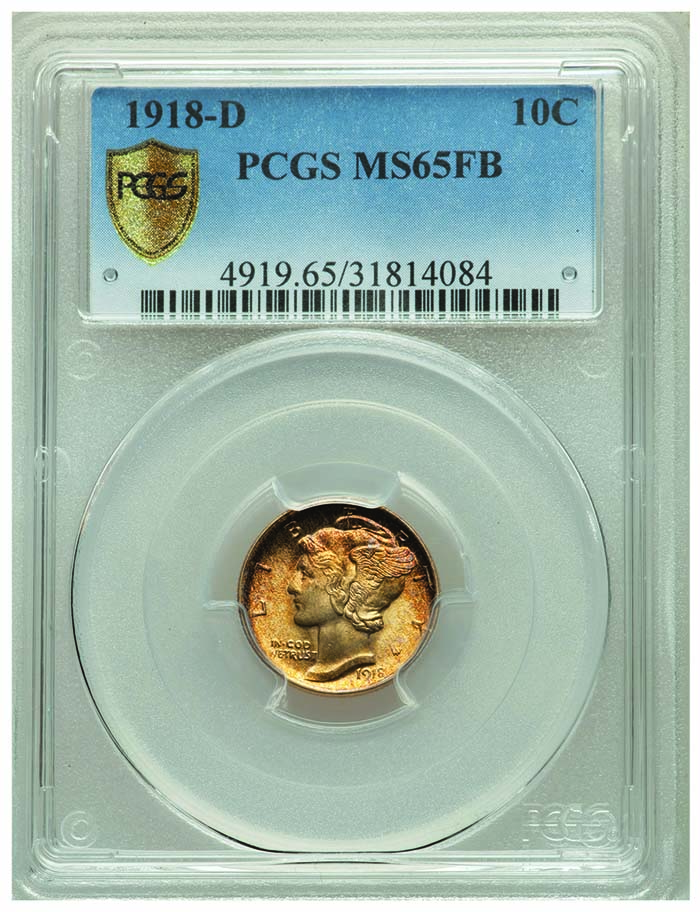
1918-D Mercury dime graded PCGS MS65 FB
In March 2019, Heritage auctioned a PCGS certified MS65FB 1918-D for $9,000. Less than five months later, in August 2019, Heritage sold a PCGS graded MS65 1918-D dime, without a Full Bands designation, for $432. Therefore, the coin with a Full Bands designation brought more than twenty times as much, nearly 2,000% more.
The central bands on both coins are a little smooth, though are clearly separated on the coin with the Full Bands (FB) designation. On both coins, the vertical and diagonal lines seem clear, and the nearby leaves are defined as usual. Why should the central horizontal bands make that much of a difference?
The $9,000 result for the just mentioned 1918-D with a FB designation was not unusually high. In June 2018, the firm called GreatCollections sold a PCGS certified MS65FB 1918-D for more, $9,281.25.
It could possibly be true that there is something disconcerting about the just mentioned PCGS graded MS65 1918-D that sold for only $432 in August 2019. Examples are listed to illustrate general points regarding FB designations. There is not a recommendation for or against any specific coin in this discussion.
In July 2020, Heritage sold a different PCGS graded MS65 1918-D dime, without a Full Bands designation, for $960. In June 2018, the firm of David Lawrence sold another PCGS graded MS65 1918-D dime, without a Full Bands designation, for $650. Each auction result for a MS65 1918-D without a designation is a small fraction of the $9,000 or more that each cited PCGS certified MS65FB 1918-D dime realized.
In the July 2020 issue of The CPG® Coin & Currency Market Review (Vol III: No. 3), the CPG® retail price estimate for a MS65 grade 1918-D dime with a FB designation was $12,100. The price estimate for a MS65 1918-D without a designation was $780.
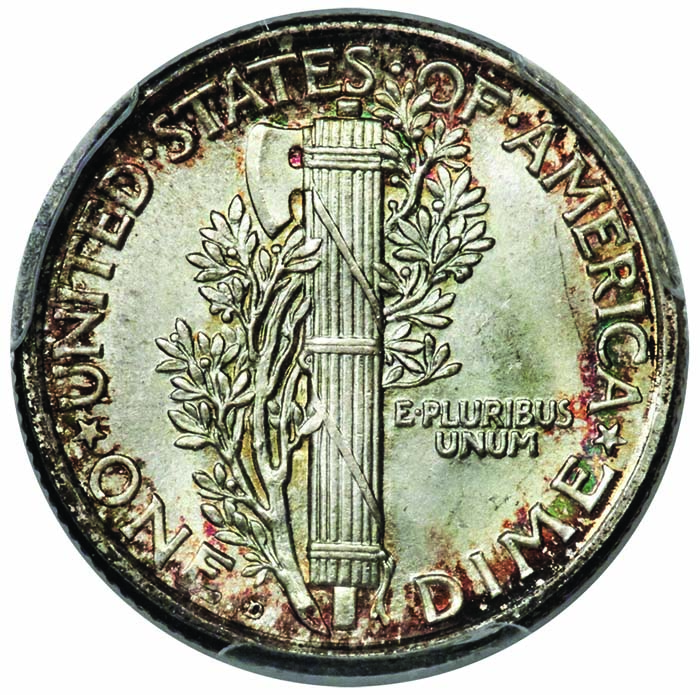
The reverse side of a 1918-D Mercury dime with sharp, full bands
The contrast in values for MS66 grade 1918-D dimes is even more startling. In June 2019, Heritage auctioned a PCGS graded MS66+ 1918-D, which did not have a FB designation, for $1,560. This coin had a sticker of approval from CAC. In contrast, twice during the year 2017, Heritage auctioned the same PCGS certified MS66FB 1918-D, for $58,750 in April and for $39,950 in August.
According to the August 2020 Monthly Greysheet, the Greysheet Bid value for an MS67 grade 1918-D dime is $2,500, while the Greysheet Bid for an MS67 grade 1918-D, with a Full Bands designation, is $140,000! The FB MS67 1918-D is thus estimated to be worth 56-times as much, a premium of 5,500%.
It is true that the FB premiums for gem quality representatives of most dates in the series of Mercury dimes are not nearly as large as the premiums for gem 1918-D dimes. Some other premiums are, though, very much substantial. The August 2020 Greysheet Bid for a MS67 grade 1928-D is $1,550 and the Greysheet Bid for a MS67 1928-D with a FB designation is $30,000!
The FB premiums for the 1945 Philadelphia mint issue are particularly puzzling. Yes, it is true that many thousands of 1945 dimes have been graded MS65 or higher by PCGS or NGC, and fewer than 100 MS65 or higher grade 1945 dimes have received FB designations from PCGS or NGC.
In the August 2020 monthly, an MS65 grade 1945 dime has a Greysheet Bid value of $17, yet an MS65 1945 with a FB designation has a Greysheet Bid value of $14,500, more than 850-times as much. The Greysheet Bid value for an MS67 grade 1945 dime is $25, yet the Greysheet Bid value for an MS67FB 1945 dime is $45,000, 1,800-times as much. Is clear separation of a pair of bands worth a premium of nearly 180,000% (one hundred and eighty thousand per cent)? If price guides and grading services did not emphasize such bands, would many collectors care whether the small bands in the center of the reverse are fully separated from each other?
While reflecting upon premiums paid for FB designated MS66 to MS67 grade Mercury dimes, I think about the fact that reverse detail does not seem to affect the values of MS66 to -68 grade Barber half dollars. A substantial percentage of the relatively more valuable Barber halves that are PCGS or NGC graded from MS66 to MS68 are not fully struck and exhibit notable lack of detail.
Actually, Barber halves have horizontal lines and also vertical lines in the shield design on the reverse. Do any coin experts care about them?
There are no recognized designations for striking detail of Barber half dollars. If there were, many of the highest graded Barber halves for respective dates would not qualify for any such designation regarding reverse detail.
There are many PCGS or NGC graded MS67 Barber halves with poorly struck wing feathers, torso feathers and/or tail feathers. Arrow tails, too, may be poorly struck or may be struck very well.
All these striking characteristics, some of which are extremely noticeable, are considered to be very minor issues. Why should the horizontal bands of a Mercury dime be extremely important, if the striking characteristics of various horizontal lines, vertical lines, feathers, claws and arrow tails on a gem Barber half are relatively unimportant and have minimal, if any, effect on the values of gem quality Barber halves?
The Hugon-Shireman 1906-S half dollar is one of the most famous of all Barber coins. It is PCGS graded MS68 and CAC approved. According to the Greysheet, the 1906-S is valued as a common date in circulated grades and commands somewhat of a premium in mint state grades. There are certainly, though, more than a dozen dates in the series that are scarcer in mint state than the 1906-S. Indeed, in mint state grades, the 1906-S is a slightly ‘better date,’ which is nowhere near as expensive as a semi-key date.
In January 2011, the Hugon-Shireman 1906-S was auctioned for $82,250. The August Greysheet Bid for a 1906-S in MS67 grade was $12,000. The Greysheet Bid for the key date 1904-S in MS67 grade is $85,000.
An immediate point is that the Hugon-Shireman 1906-S commands a tremendous premium over a MS67 grade 1906-S and over many other dates in the series of Barber halves, even though the Hugon-Shireman 1906-S Barber half is not close to being fully struck. There are weakly defined feathers on all sides of the shield, left, right, above and below. The claw holding the arrows lacks detail. The arrow tails appear soft and not well formed. The leaves are not as well struck as they are on many other Barber halves. There is a noticeable soft area where the eagle’s neck meets the head. If it was a Mercury dime, the bands would be soft and blurry, and other parts of the reverse would lack detail. As the lack of detail on Hugon-Shireman 1906-S half dollar does not affect the value of it, why should the presence or absence of Full Bands affect the value of a better date Mercury dime?
The Hugon-Shireman 1906-S has realized at auction more than four times as much as any other 1906-S half despite several weakly struck areas on the reverse. Also, the two 1904-S halves that have each sold at auction for more than $100,000 are not fully struck either; these have many blurry feathers.
It is not true that all San Francisco Mint Barber halves lack considerable detail. The Gene Gardner 1899-S was PCGS graded MS68 and CAC approved. While it was not fully struck, it exhibits far more detail on the reverse than the just mentioned Hugon-Shireman 1906-S.
Overall, there are many PCGS graded MS67 Barber halves that are very well struck and there are many PCGS graded MS67 Barber halves that are not very well struck. Striking details do not seem to be a leading factor in the value or grade of Barber half dollars.
It may be worthwhile to consider two PCGS graded MS67 and CAC approved 1864 Liberty Seated half dollars, the coin that was in the George Marin Collection and the coin that was in the Gene Gardner Collection. Pictures of both may be easily found in the Heritage auction archives.
The difference between the two that is pertinent to this discussion is that the George Marin 1864 is incredibly well struck while the Gene Gardner coin is very noticeably missing much detail in a group of feathers above the claw that is clutching the branch. This claw is not well struck either.
The immediate point is that the 1864 half with very noticeable striking weakness received the same PCGS grade and the same CAC approval as the coin that was incredibly well struck. Of course, eye appeal and surface quality are more important factors in the determination of the MS67 grade assignments for these two coins. Nevertheless, no one has suggested that the incredibly well struck George Marin 1864 half should be worth multiples of the value of the Gene Gardner 1864 half dollar. Of course, striking detail will matter more to some collectors than to others.
If a collector finds Full Bands designations in regard to a Mercury dime to be very interesting or culturally noteworthy, then I could understand why he or she may be willing to pay a 10% premium for each. It is premiums that range from 200% to more than 50,000% that are astonishing.
Copyright ©2020 Greg Reynolds
Insightful10@gmail.com
Images courtesy of Heritage Auctions

Download the Greysheet app for access to pricing, news, events and your subscriptions.
Subscribe Now.

Subscribe to The Greysheet for the industry's most respected pricing and to read more articles just like this.
Source: Greg Reynolds
Related Stories (powered by Greysheet News)
View all news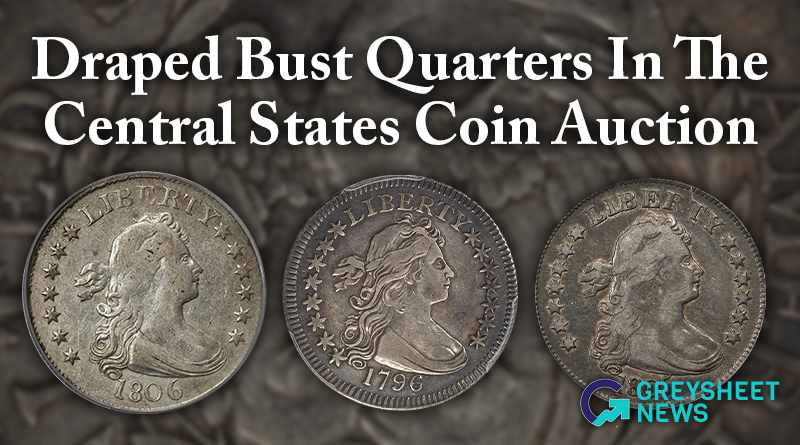
The Lusk set of Draped Bust quarters brought strong results.
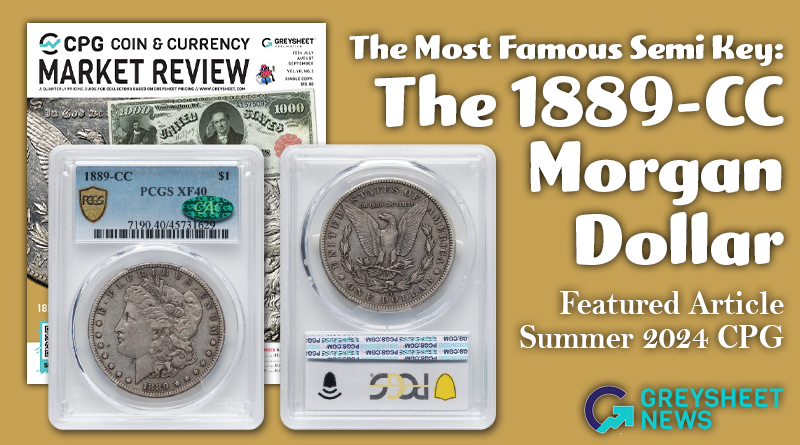
The 1889-CC is the second scarcest business strike in the series.
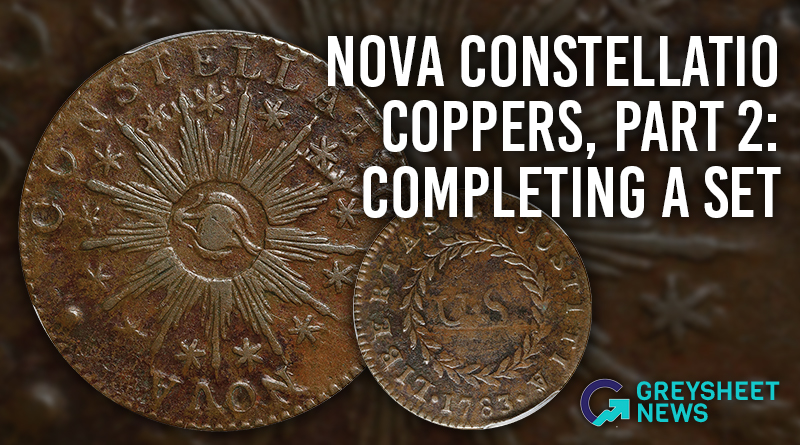
Just six coins are required for a set of true Nova Constellatio Coppers, and the coins selected need not be very expensive.









Please sign in or register to leave a comment.
Your identity will be restricted to first name/last initial, or a user ID you create.
Comment
Comments